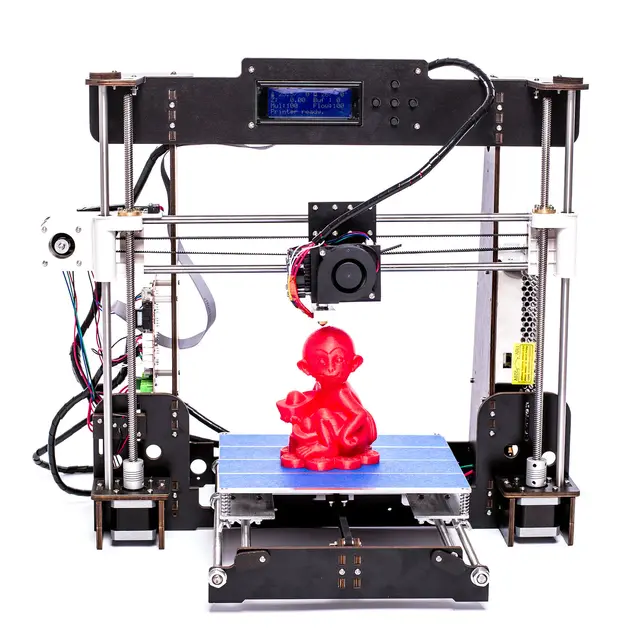Natural robotics 3d printer
Natural Robotics VIT 3D Printer In-Depth Review
7.5Expert Score
Natural Robotics VIT
Natural Robotics VIT has been designed and manufactured in Barcelona. And it aims to reinvent the Selective Laser Sintering for individual use and small-scale productions.
Affordability
5
Quality
8
Speed
7
Capability
8
Practicality
8
User Expectations
9
PROS
- Fast printing with dimensional accuracy.
- A considerable amount of build volume.
- Stable printing.
CONS
- The printer has an enclosed design due to which the post-processing of parts is an issue.
Natural Robotics VIT SLS 3D Printer
VIT SLS is a desktop SLS 3D printer from Natural Robotics. The printer uses SLS Selective laser sintering technology and is capable of creating the . ..
Add to wishlistAdded to wishlistRemoved from wishlist 0
Add to compare
|
Table of Contents
VIT SLS is the 3D printer that is manufactured by Natural Robotics which is a company based in Barcelona. This printer was presented for the first time as the first low-cost Selective Laser Sintering (SLS) printer on October 24th, 2017.
This printer was presented for the first time as the first low-cost Selective Laser Sintering (SLS) printer on October 24th, 2017.
The platform where it was presented was Kickstarter. The aim of the manufacturer here was to make high-quality additive manufacturing technologies available to all businesses who cannot afford to spend as much as industrial grade manufacturers demanded from them.
With this aim in mind, the Catalan start-up began a few years before 2017 and developed FDM printers.
It is in the latter part of the time that they realized SLS’s importance. Keeping this knowledge, they created their newest printer, aiming to affect businesses across the world.
This SLS printer is designed for 3D printing with types of polymer powders, at an affordable price like never before. VIT SLS is capable of producing prototypes and short runs, that have great quality and definition.
The printer has been designed and manufactured in Barcelona. And it aims to reinvent the Selective Laser Sintering for individual use and small-scale productions.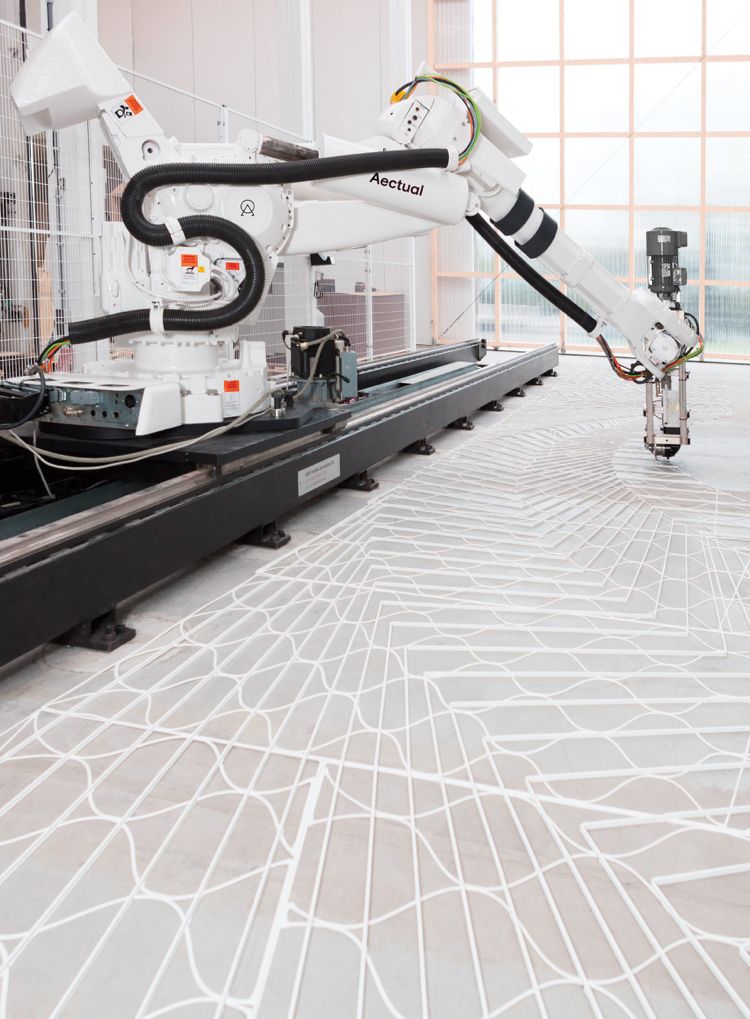
Credit: kickstarter.com
The manufacturer claims to have manufactured this printer after analyzing the main problems that arose in the 3D printing market. These were problems for the users of this technology.
The company has detected the needs and set out to find solutions for every one of them by giving the different products out of which VIT SLS is one of them.
In this article, you’ll get to know about the features, specifications, print quality, and many such aspects in detail. So, let’s get started.
Features
Credit: kickstarter.com
The VIT SLS is a desktop 3D printer that is based on SLS 3D printing technology. At the time when it came into existence is was the first printer that offered users to print using SLS 3D printing technology as a desktop printer.
Until then it was common for desktop 3D printers to use FDM technology, but not SLS. So, it was a breakthrough desktop 3D printer and above it, it had some breakthrough features about which you would learn in this section.
But before that, a general differentiation between both technologies would let you understand how this printer was a breakthrough printer.
With the invention of SLS 3D printing technology, the news in the market was that SLS generally offers more accuracy in detailing of complex geometries compared to FDM 3D printing.
So, until this printer came into being, in the market, there were parts and functional prototypes available that were made using SLS 3D printing.
But these were made from industrial 3D printers. So, to standby in this competition, being a small business owner was no chance.
And after this invention and a bunch of others like this, small business owners stood some chance with which they could also offer the accuracy in parts and functional prototypes that their client demanded, which was more than offered by FDM 3D printers.
Now, jumping on to the features of this printer.
Commendable Print Speed
The general conception of any 3D printer that offers good print quality is that it would compromise on the print speed. This is the stereotype that is present in the market.
This is the stereotype that is present in the market.
So much so that a printer that offers both is almost a myth. When this printer came into the market, the general print speed of printers that printed with FDM 3D printing was 50 mm per hour. And the quality was average, but not like that of SLS 3D printers.
This printer claimed to offer a print speed of 20 mm per hour. So arguably FDM 3D printer users had to compromise 30 mm per hour for using this printer, but at the cost of the same, they would obtain intricate detailing in parts and functional prototypes.
So, it was a balance that this printer offered, which also made it a breakthrough printer.
And in a way it took the market to a stir with this balance which was so unique in its sense that users, on one hand, did not have to compromise on the speed for nothing, the got the quality at the cost of a considerable amount of compromise in the print speed.
Standalone 3D printing
This feature was again something that made this printer stand out from many others on the list. At that time, almost all the printers that were desktop 3D printers and based on FDM 3D printing technology required a computer to operate with.
At that time, almost all the printers that were desktop 3D printers and based on FDM 3D printing technology required a computer to operate with.
Otherwise, manual operation or an alternative to computer operating the printer wasn’t available in the market.
In those times, there was this printer that offered users comfort, allowing them to operate even without a computer. Users who didn’t know much about computers and still wanted to do business in 3D printing were considered by the manufacturers of this printer.
And this made the printer a warmly greeted printer by all sorts of users, including the ones who knew how to operate, the other ones, and the one in the middle.
Of course, the printer can get connected with wi-fi and allow users to operate with that too. But it doesn’t impose any sort of restriction.
So, if you are someone who does not know how to operate 3D printers with computers, you could still do the same work as the one who knows to operate it using computers.
7-inch touch screen user interface
Having a touch screen interface was getting common in times when this printer came into being. So, the manufacturers of this printer took into mind the latest trend and avoided being traditional about the user interface offering in their printer.
They did not offer the button interface that was traditional and old. Instead, this modern user interface was chosen by the manufacturers.
Of course, we all are familiar with the comfortability that any touch screen device offers. We love it so much that every smartphone nowadays comes with one.
Also, it’s a huge touchscreen interface for the price range and desktop printer category that this printer is classified into. Most of the 3D printers of those times, if you see, would have a touch screen interface but not this huge.
To have a huge touch screen interface is to be able to operate multiple things from a single screen with convenience. You also need to remember less.
Specifications
Credit:kickstarter.com
Because this printer works on a selective laser sintering system, the printer boasts its ability to 3D print objects without the need for supports.
Material needed for printing i.e. the powdered polymer is kept in the feedstock which also facilitates the packing of multiple parts in a single print bed. Not only that, but it also allows a percentage of unused material to be recycled for future jobs.
The maximum print volume is 250 mm x 250 mm x 250mm. VIT SLS operates using a CO2 40W laser and 3D prints at a maximum speed of 20mm per hour.
Using this printer, jobs can be started without the need for a computer connection. Although the machine also offers printing with USB, Wi-Fi, and Ethernet connectivity as a backup.
The interface that is used in this printer is 7 inches long touch screen display. The dimensions of this printer are 800 mm * 600 mm * 950 mm.
Price
The printer is priced at $12,900 as mentioned on the manufacturer’s website.
First Impressions
Credit: 3dnatives.com
The 3D printer is rectangular. The front view of the printer has two major portions, the upper portion and the lower one.
The former has a black colored translucent glass, while the latter has a touchscreen beneath which is one red-colored button. The VIT’s logo is printed on the upper portions.
The sides of the printer are silver colored. There is a white handle in the upper portion of the printer through which it can be opened. And materials can be fed in it, or print head adjustments can be made.
Besides the touchscreen, there is a USB port with which also you can connect with the printer.
Setup
The printer comes completely assembled, you do not need to calibrate the print bed or join some screws for fixing the print bed. When you open the upper portion you can see the print bed.
All you need for setting up the printer is to read the manual that comes with the printer and see some videos if necessary.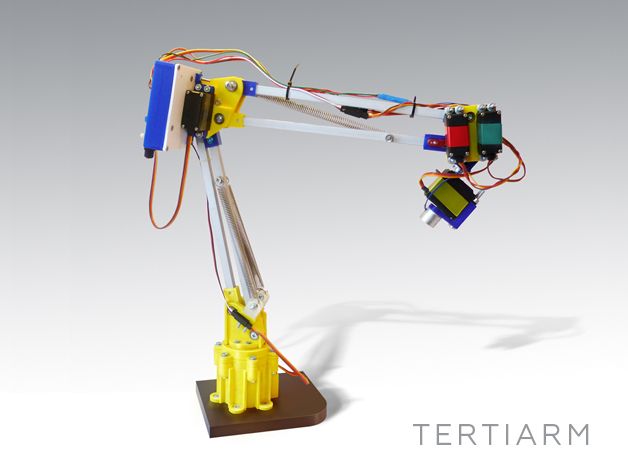 You can also contact the manufacturer if you need any assistance.
You can also contact the manufacturer if you need any assistance.
The printer needs to be placed on a table that has a little more dimensions than what the printer has.
Printing Type/Cost
Because this printer uses SLS printing technology the printing cost of this printer has to be more than any FDM based 3D printer. In return for this cost what the printer offers is a high-quality production of parts and functional prototypes.
SLS technology uses Laser as the source which will solidify the liquid resin. The work that is done by the filament in FDM is done by resin in SLS 3D printing.
Whilst the work done by heating is done by lasers. Although, both in SLS and in FDM the printing is done layer by layer so the first layer deposition pretty much holds the result of the coming layers in terms of quality.
Print Quality
Credit: kickstarter.com
As mentioned many times in this article, this printer’s print quality is very more than even industrial level FDM 3D printers, just because of the use of laser in curing the material that is used for 3D printing.
You will see the difference when you print the first layer of any part or functional prototype using FDM and the same using SLS.
Also when the part is completely manufactured, the printer ensures that there are no layers visible on it and if they are, their amount is minimal.
Software™
The manufacturers of this printer have kept a local software compatible with this printer as per the website of this manufacturer. If that is so, the printer does not allow you to print with open-sourced software.
This is not that good because then if you are a regular 3D printing technology user, you need to learn that software specifically and it might not have the same settings as the software that you know.
Customer Service
Not only does Natural Robotics offer technical assistance for the printers they manufacture but also for other brands.
There is this option of services on their website on clicking on which you can opt for multi-brand technical assistance if you wish to. Isn’t that great? For VIT, you have a warranty which is mentioned on the company’s website.
Isn’t that great? For VIT, you have a warranty which is mentioned on the company’s website.
Apart from that, you can call the company’s phone number that is provided online, you can even fill the contact form or contact via email. If need be the company’s agents would also help you out via Skype.
Parameters Influencing Buying Decision
Below mentioned are some of the factors in brief that would let you determine whether you should or should not buy this printer.
3D Printer Cost: The price at which it started selling in the market was justified.
3D Print Quality: Being an SLS printer, it can offer the quality that even most FDM industrial printers fail to offer.
3D Print Speed: Industry standard.
3D Printer Capability: The printer offers printing with third party resins also.
3D Printer Practicality: VIT SLS has applications in various fields.
3D Printer User Expectations: Small business owners’ expectations is something the printer satisfies the most.
Verdict
For all those who want a higher quality of 3D print than FDM printers by spending a reasonable amount, this printer is your go-to.
Natural Robotics Launches Another Low-Cost SLS 3D Printer « Fabbaloo
By Kerry Stevenson on October 26th, 2017 in printer
Tags: powder, sls
The new VIT SLS 3D printer from Natural Robotics is now available for orderBarcelona-based Natural Robotics has launched a very interesting SLS 3D printer on Kickstarter today.
The machine, known as the VIT SLS, is one of several new lower cost options that utilize the well-known SLS process. SLS, or Selective Laser Sintering, involves blasting the flat surface of a powder layer with a powerful laser to fuse particles together. By repeating this process over many layers, complex objects can be produced in high resolution.
The major advantage of the SLS process is that there is no need for support material, as each layer is supported by unfused powder beneath it.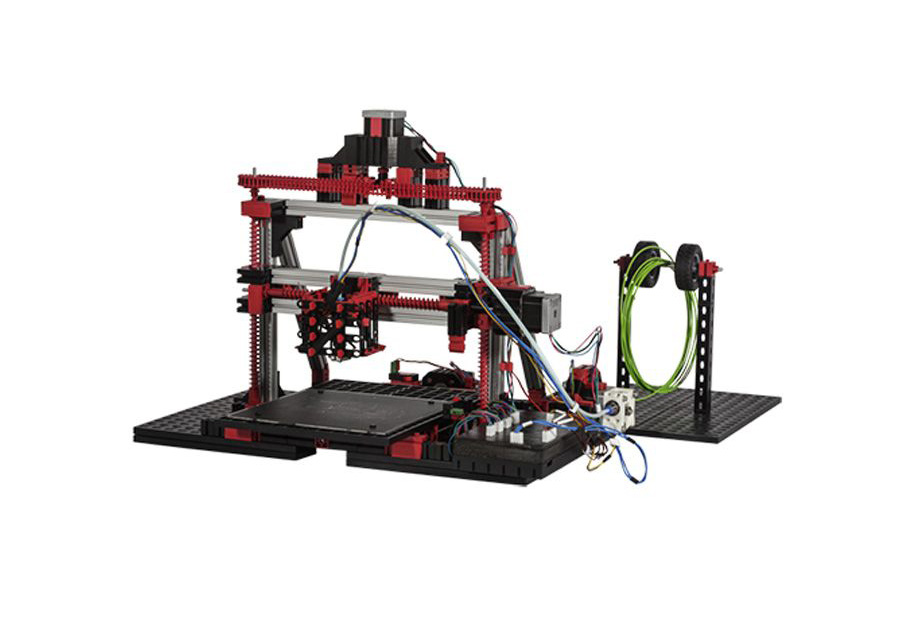 When a SLS print completes, you must dig it out of a chamber full of loose powder. This means that you have virtually no geometric constraints on the object and can print extraordinarily detailed items without fear of failure.
When a SLS print completes, you must dig it out of a chamber full of loose powder. This means that you have virtually no geometric constraints on the object and can print extraordinarily detailed items without fear of failure.
SLS has been around for a very long time, having been first popularized by 3D Systems and EOS, whose industrial SLS systems are used worldwide. Unfortunately, while their equipment is of very high quality, they also carry very high price levels, putting it out of reach of many.
The good news, at least for buyers, is that the original patents on this process have or are about to expire, opening up the possibility of others making lower cost equivalents. And this is certainly the case with entries from SinterIt, FormLabs and Sintratec.
Now they’r joined by newcomer Natural Robotics, who previously (and I suppose still do) manufacture high quality delta-style plastic extrusion 3D printers.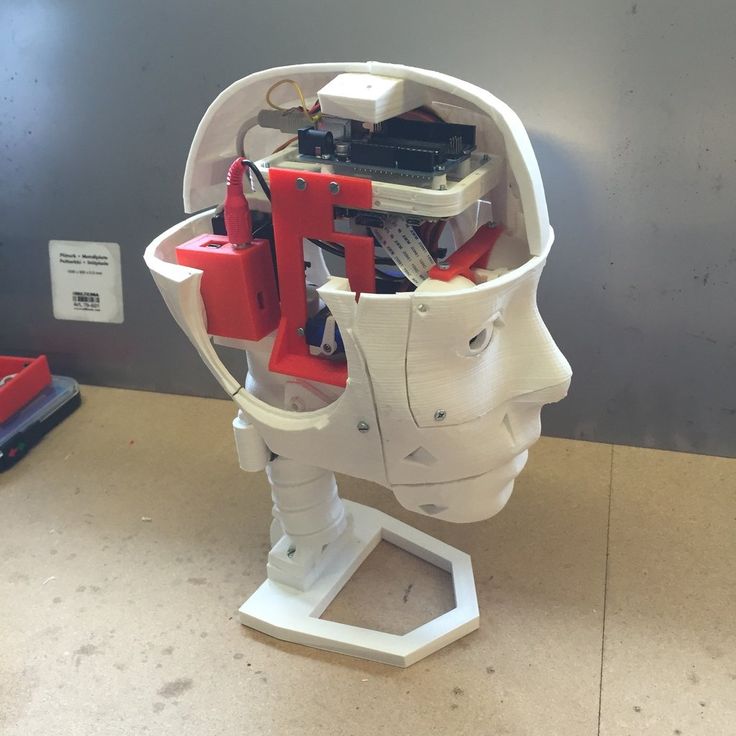 This is a big jump for them, with an entirely new 3D printing process. They say:
This is a big jump for them, with an entirely new 3D printing process. They say:
The new Natural Robotics VIT SLS 3D printerReinventing the Selective Laser Sintering for individual use and small-scale productions. After analysing the main problems that arose in the 3D printing market for the users of this technology, we detected the needs and set out to find solutions for each and every one of them.
The VIT SLS machine includes a healthy build volume of 250 x 250 x 250mm, and is connected by various common networking options. The 40W single internal laser is capable of fusing many different appropriately powdered polymers, including the frequently used polyamide material.
A sample 3D print from the Natural Robotics VIT SLS machineIn this video you can see the dual powder tanks on each side of the build chamber, which permits somewhat faster printing because the layer recoating arm needs to move only one direction per layer.
The VIT SLS 3D printer has been in prototype mode for some time, but is now being offered for public sale. At launch, the company has decided to use Kickstarter as their launch platform and has specified a very interesting discount: While their standard retail price is said to be USD$11,100, at launch you can get one for only USD$7,100. That puts their product square in the range of the other low-cost SLS providers.
At this price, a great many more companies may take up the powerful SLS process for their 3D printing options. Remember, different tools are best suited for different requirements, and it may be important to have more than one 3D printing process at your disposal.
Via Natural Robotics and Kickstarter
Twitter Kerry Stevenson, aka "General Fabb" has written over 8,000 stories on 3D printing at Fabbaloo since he launched the venture in 2007, with an intention to promote and grow the incredible technology of 3D printing across the world. So far, it seems to be working!
So far, it seems to be working!
View all of Kerry Stevenson's posts.
Home 3D printer
04/30/2020
Why do you need a 3D printer? - this question is often asked by those who have not encountered 3D printing and do not realize the potential of its application, and the 3D printer itself seems to be something fantastic or useless.
3D printing technology is quite young and there is not much information available about it. Today, a 3D printer for home use is bought mainly by people who are passionate about certain hobbies: creating art objects, modeling, character painting, robotics, etc. But another decade will pass, and having a 3D printer in the house will become as common as a set of tools in the pantry.
So why do you need a 3D printer at home?
The main benefit of 3D printing in everyday life is that you can create almost any object yourself.
Plastic parts
Imagine that you have broken the plastic part of the refrigerator mount, which has been out of production for ten years. Of course, you can stock up on electrical tape, but the aesthetic appearance will be lost. And you can print exactly the same part on a 3D printer, and even match the color of the plastic to match the broken part.
On a 3D printer, you can easily print any parts that are difficult to buy or find the right ones: buttons, knobs, caps, gears, etc. Already now, 3D models for printing plastic parts from IKEA furniture, spare parts for household appliances, LEGO parts, parts of popular toys, etc. can be freely available.
Household items and accessories
3D printing of household items is perhaps the most common topic. Sites with 3D models are full of all kinds of gadget accessories, mounts, stands, shelves, vases, lamps, kitchen and garden utensils.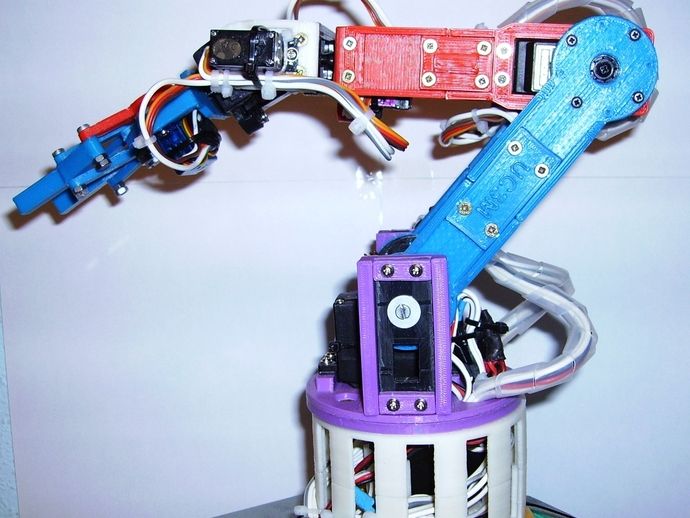
Toys
More and more 3D printed toy models appear on the web every day. They print everything from movie characters, board games, puzzles and doll utensils to quadcopters, radio-controlled car parts, and even robots.
By the way, for children, 3D printing is a separate delight. And not only the result, but also participation in the selection process itself, preparing the model for printing and monitoring the printing itself. Therefore, if there are children in your family, then keep in mind that, most likely, the 3D printer will work non-stop.
Parts
3D printing of spare parts is relevant for those who like to repair a car, motorcycle or bicycle on their own. Often small parts are sold only assembled with the main mechanism or in batches, which makes sense only for auto repair shops.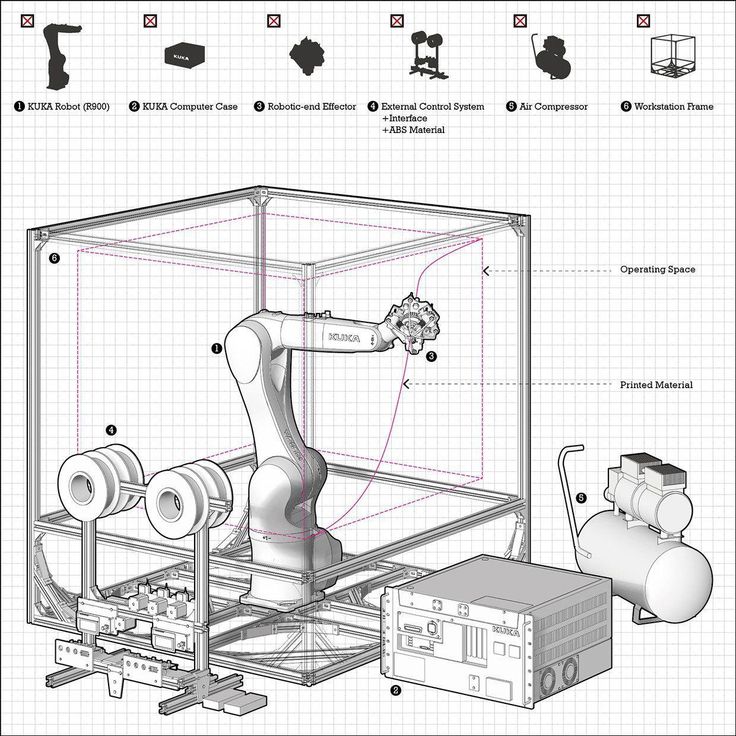 In this case, a 3D printer is a good savings. Printing one necessary part or element of the assembly will cost several times cheaper.
In this case, a 3D printer is a good savings. Printing one necessary part or element of the assembly will cost several times cheaper.
Which 3D printer is suitable for the home?
To print most items, a 3D printer that prints with PLA plastic is enough. It is the easiest material to work with, and it is also food-safe, so you can print children's toys, biscuit molds, fruit bowls, etc. from it.
For printing items for the home and toys, 3D printers are perfect, sharpened to work with PLA plastic - this is Wanhao i3 Mini and D10 . Both models are compact and can easily fit even on a tiny table, the printers are fully assembled and ready to go right out of the box, and even a child can handle the connection and setup.
Parts, fixtures, and appliances often require a material stronger than PLA to print. For these purposes, it is worth choosing a model with a heated platform and an operating temperature of the extruder up to 260 C. This will be quite enough to use durable plastics such as ABS, nylon or polycarbonate.
This will be quite enough to use durable plastics such as ABS, nylon or polycarbonate.
Of the budget home models, such 3D printers are Wanhao i3 v2.1 and i3 Plus v2.0 . The printers are easy to use and have proven to be reliable, workhorses.
When planning to buy a 3D printer for your home, it is important to understand that this is not just another toy, but a full-fledged working tool.
the most advanced projects of 2022
Robots and 3D printing - a powerful combination! Let's take a look at some of the most impressive and cutting-edge 3D printed robot designs, many of which you can make yourself at home.
Humanoids
Combining robotics and 3D printing, humans push their limits every day, and humanoid robots are a perfect example.
Humanoid robots are designed to somehow represent or mimic the appearance and actions of a human. Every day, experts are working on the creation of new robotic systems, trying to make them as close to reality as possible.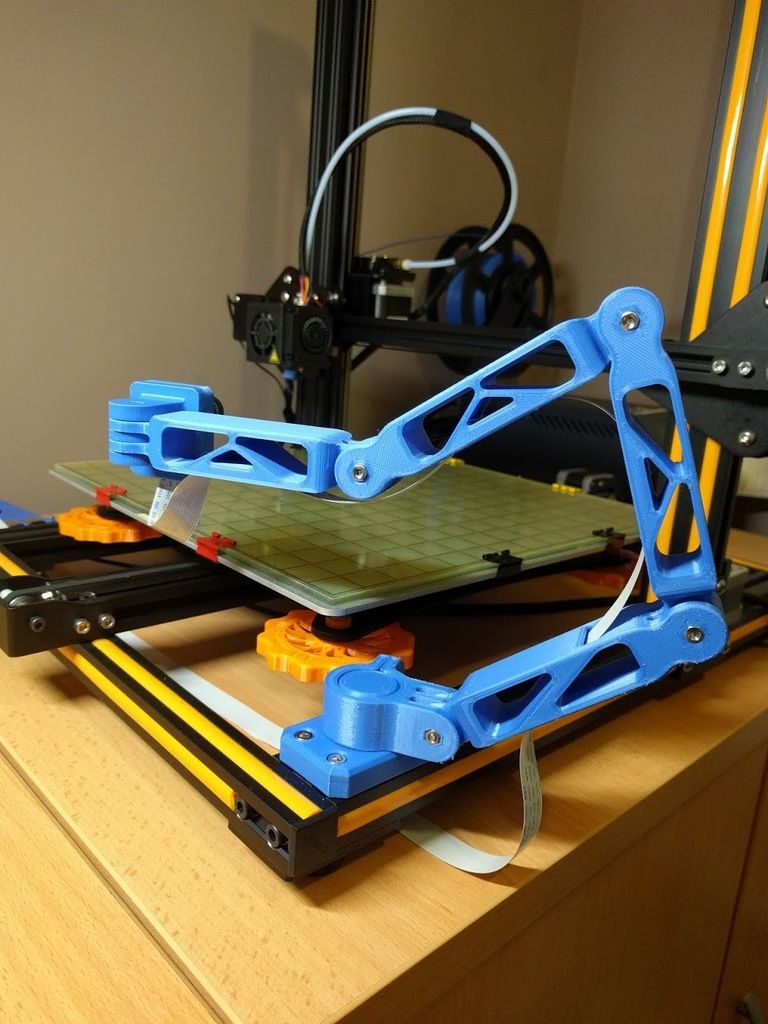 Humanoid robots can walk, talk, gesticulate, and more. They are suitable for many applications including medicine and nursing.
Humanoid robots can walk, talk, gesticulate, and more. They are suitable for many applications including medicine and nursing.
Let's look at some interesting models of humanoid robots, popular among amateurs and professionals in the field of robotics.
1. Kengoro (Kengoro).
This humanoid robot, created by researchers at the University of Tokyo, can do more push-ups than anyone else. When developing it, scientists focused on muscle abilities.
Force is a big problem for articulated robots. As the number of degrees of freedom and accuracy of movements increase, their muscle strength decreases.
But Kengoro does not have this problem. He can do push-ups, play sports, run and even play badminton. To perform all of the above, the robot does not require any remote control, since all its movements are independent. For example, when playing badminton, this humanoid performs all the necessary movements, determines the direction of the shuttle and moves in the right direction at will.
One of the secrets of Kengoro's abilities is built-in cooling, which mimics a person's ability to regulate their body temperature. During certain physical activities, the robot artificially sweats to cool the mechanism, which allows it to work more efficiently and for a longer time.
What role did 3D printing play in the creation of this humanoid robot? The mechanical parts and frame of the Kengoro were manufactured using selective laser sintering (SLS).
2. InMoov
InMoov is one of the oldest projects in the field of 3D printed robotics. Created by French sculptor and designer Gaël Langevin in 2012, this robot originally served as a prosthetic arm. Its design has been gradually modified and improved, and now it is a life-size 3D printed robot. This model is a truly impressive achievement, not only due to its size, but also due to the smooth, graceful gestures right down to the fingertips. In addition, it is an open source project intended as a development platform for students, developers, and scientists.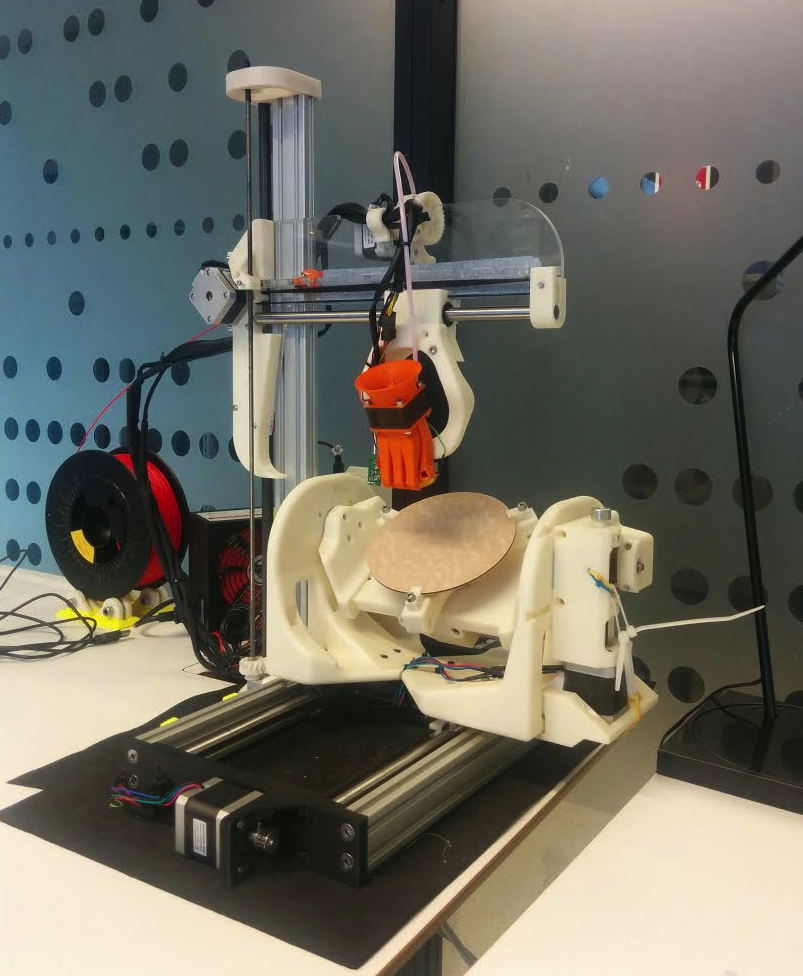 In fact, InMoov was the first open source 3D printed prosthetic arm.
In fact, InMoov was the first open source 3D printed prosthetic arm.
You can make your own InMoov robot. To do this, you will need:
- desktop 3D printer, the print volume of which is at least 12x12x12 cm, for example, the Picaso Designer Classic model;
- Arduino Uno and Mega microcontroller boards;
- three servomotors - HK15298B, HiTec HS805BB, MG996;
- software - MyRobot Lab, Python.
InMoov continues to be a favorite among developers around the world. Every year it gets more and more opportunities. For example, its design has recently been improved by adding a vision system, improved mechanics and legs.
Fun fact: there is a world map that can be used to connect with the creators of InMoov around the globe.
3. Reachy.
In 2019, the French company Pollen Robotics introduced its highly interactive Reachy AI robot. Richie is a 3D printed robotic torso capable of playing tic-tac-toe or, for example, serving coffee. The main purpose of its development is use in the field of customer service.
The main purpose of its development is use in the field of customer service.
The robot looks pretty cute with animated antennae and a head with two "eyes" that can move to convey emotions. Richie's arms have a wide range of motion, are similar in size to those of an adult, and are capable of lifting objects weighing up to 500 grams. You can use VR to control the robot.
Every part of Reachy is 3D printed. In addition, Pollen Robotics has made its design open so that anyone can contribute to the development of this robot.
Ritchie is available in a number of different configurations, ranging from the basic one-handed and headless model to the advanced head-and-two-armed version. You can even choose a robot shirt design!
4. ED-A.
This robot looks like it's straight out of a science fiction movie, but it's actually real. The name of this impressive humanoid is ED-A, or simply Eddie. It was designed by an engineer named Greg at Gwas Tech and is a fully 3D printed robot using artificial intelligence and machine learning. In development mode, Eddie's robot can be controlled both by voice and by remote control.
In development mode, Eddie's robot can be controlled both by voice and by remote control.
ED-A can talk, walk and turn as instructed, as well as notice and address the presence of a person. He knows how to form opinions about what he likes or dislikes. In addition, Eddie is friendly to animals: he can talk to dogs, give them treats and even train them!
Developer Eddie shares his progress on YouTube and Instagram so everyone can watch the robot evolve as new features are added. You can see some very advanced features in the developer videos. For example, how the robot uses its own voice to communicate with users. And in one of the videos, the author shows the robot various objects, in particular, a keyboard and an electric screwdriver, and ED-A recognizes them, pronounces their names and expresses their own opinion about these objects.
5. Jimmy
Jimmy has a friendly design. This is a 21st century humanoid robot with the technical name Interbotix HR-OS1, powered by an Edison chip from Intel. The model was created in 2014 and has an open source code that can be controlled remotely via Wi-Fi. Development of the robot Jimmy continues to this day.
The model was created in 2014 and has an open source code that can be controlled remotely via Wi-Fi. Development of the robot Jimmy continues to this day.
This robot is based on an endoskeleton, and the outer shell, which gives Jimmy a friendly look, can be printed and customized to the user's taste. You can customize not only the shell, but also the functionality of the machine. By the way, this is even desirable and highly encouraged, as developers are actively promoting such an aspect as personalization.
Jimmy has many skins available. Since its development, this robot has been regularly used in many educational campaigns, as well as in the field of social work with children with special needs. One of his shells, called Callim, was designed by an 11-year-old boy, and the 21st Century Robot team turned it into a real 3D printed exoskeleton.
6. Aspir V2
The Aspir V2 is an open source 3D printed humanoid robot with a lot to talk about. In 2018, the first Aspir was released - an "autonomous robot for support and positive inspiration", created by John Choi based on the "Robot Ambassador Halley" (2015). A year after Aspir, a second version was released called Aspir V2. With its "childish" size - height 4 feet (a little over 1.2 m) and weight of only 30 pounds (about 13.5 kg) - this robot operates with the help of 22 motors. It is equipped with humanoid automation and is highly maneuverable. There are six extra-large servos per leg, and four high-torque standard servos per arm. In addition, each arm is equipped with five metal gear micro-servos. To top it off, the robot has two additional standard servos for head tilt and turn mechanisms.
A year after Aspir, a second version was released called Aspir V2. With its "childish" size - height 4 feet (a little over 1.2 m) and weight of only 30 pounds (about 13.5 kg) - this robot operates with the help of 22 motors. It is equipped with humanoid automation and is highly maneuverable. There are six extra-large servos per leg, and four high-torque standard servos per arm. In addition, each arm is equipped with five metal gear micro-servos. To top it off, the robot has two additional standard servos for head tilt and turn mechanisms.
Each of the 90 parts that make up the Aspir V2 is 3D printed. The total printing time for all elements is approximately 300 hours. To make a robot yourself, you will need: a 3D printer with an assembly volume of at least 250x250x250 mm, for example, the Hercules G6 model, 5 kg of PLA plastic filament, files from GitHub. A complete guide and a list of available materials can be found on the Instructables website.
7. Atlas
The Atlas robot, developed by Boston Dynamics, is one of the most popular robots among Internet users.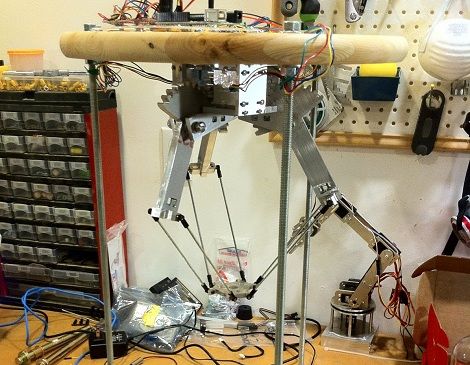 However, only a few people know that it is partially 3D printed. The model was based on the earlier Peatman humanoid robot from Boston Dynamics and was originally designed to perform search and rescue missions.
However, only a few people know that it is partially 3D printed. The model was based on the earlier Peatman humanoid robot from Boston Dynamics and was originally designed to perform search and rescue missions.
According to the manufacturer, Atlas has been designed to push the boundaries of "whole body mobility". His arms and legs are 3D printed in metal. Because of this, they are endowed with sufficient lightness and strength to perform the gymnastic movements for which this robot is designed.
The original versions of the Atlas, developed in 2013, were purely mechanical. But in recent years, the possibilities of 3D printing with metals have reached such a high level that it has become possible to produce functional parts for such maneuverable robots.
8. Biomimetic Mechatronic Hand (biomimetic mechatronic hand)
This robotic hand is incredibly similar to the real thing! It was designed by Will Cogley and is currently a work in progress. The biomimetic mechatronic hand is a university project that aims to create a mechanism that mimics the motion, grip and strength of the human hand as closely as possible.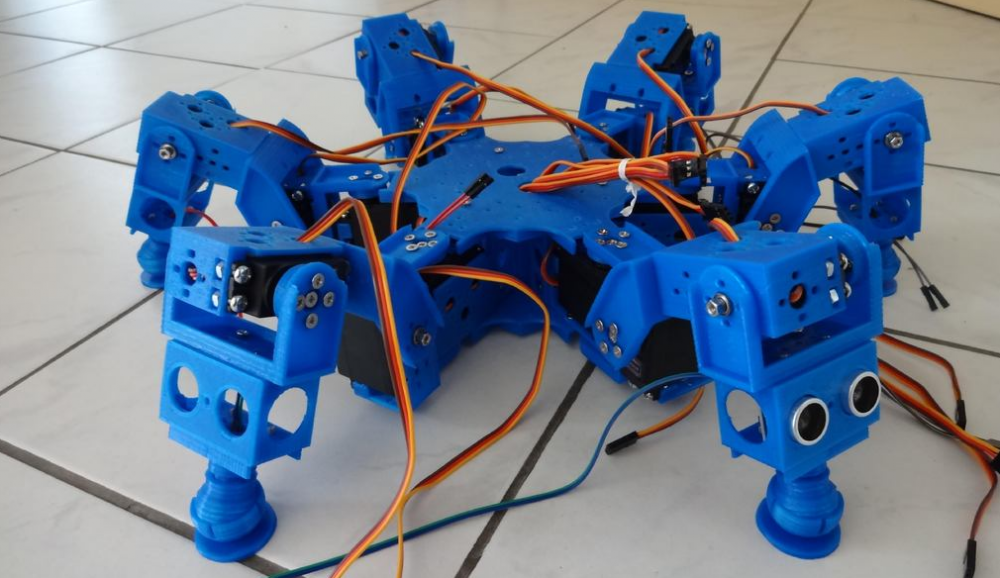 At the moment, the first criterion of the three has already been achieved.
At the moment, the first criterion of the three has already been achieved.
The human hand is made up of many muscles and tendons and is therefore a big problem in the field of prosthetics. The creation of the mechatronic hand was a very successful attempt to replicate real hand movement systems. To date, this mechanism has an impressive 23 degrees of freedom and is able to exactly repeat the movements of a real hand. The developer plans to improve the grip so that it can be as effective as gripping a real hand. This is what the author focused his attention on: now he is studying the possibilities in terms of increasing the strength of the structure.
Robotic arms
Robotic arms are mechanical systems consisting of axes that are connected to each other to give the arm different degrees of freedom and provide different types of movement. The limbs of such a mechanism are able to turn and rotate to reproduce a certain movement.
Robotic arms are based on software, the type and functionality of which depend on the function that the mechanical arm is to perform.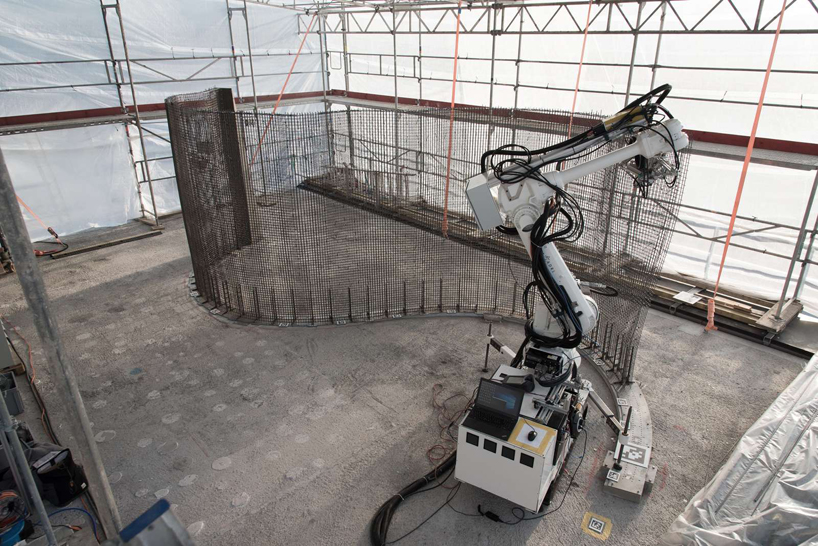 At the same time, most robotic arms are very similar to each other and differ only in the data transmission method used and the programmed movement.
At the same time, most robotic arms are very similar to each other and differ only in the data transmission method used and the programmed movement.
Not so long ago, robotic arms were used primarily in industry, but thanks to 3D printing, they can now be used at home as well.
Below are the best robotic arms available today.
1. LittleArm V3
LittleArm V3 is a fully 3D printed Arduino-based robotics kit based on the first LittleArm project that was developed in 2016. With a 3D printed grip, this robot arm is easier to assemble than previous versions.
LittleArm Robots is a project by designer Gabe Bentz to introduce the STEM (Science, Technology, Engineering, Mathematics) model into the learning process. When he succeeded, he realized that he would have to make more robotic arms than expected. This led to the creation of a huge printer farm, which later became Slant 3D. Based on this company, a line of LittleBots robot kits with Arduino, designed for learning STEM, was created.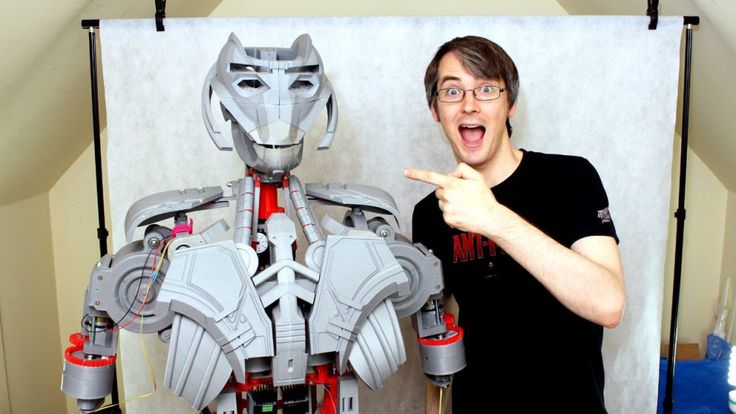
LittleArm V3 consists of only four 3D printed parts and does not require screws to articulate the grip. Instead of screws, an integrated 3D printed hinge is used. The overall design of the device looks quite elegant. The hand is easy to assemble, has an improved grip and, unlike previous versions, is equipped with an updated version of the software. The V3 is perfect for use as a learning tool for kids, but can be used by adult robotics enthusiasts as well.
2. Niryo One
Niryo One is a 3D printed 6-axis robotic arm designed for collaboration in education. The model was developed in 2016 and is available for purchase both as a set and fully assembled. Originally launched on Kickstarter, Niryo developed through software and design improvements.
The Niryo One robotic arm is used to introduce industrial robots. It is very precise and controlled by stepper motors, which are in turn controlled by the Arduino and Raspberry Pi systems. The device is easy to program - the process is done using a free desktop application and takes less than five minutes.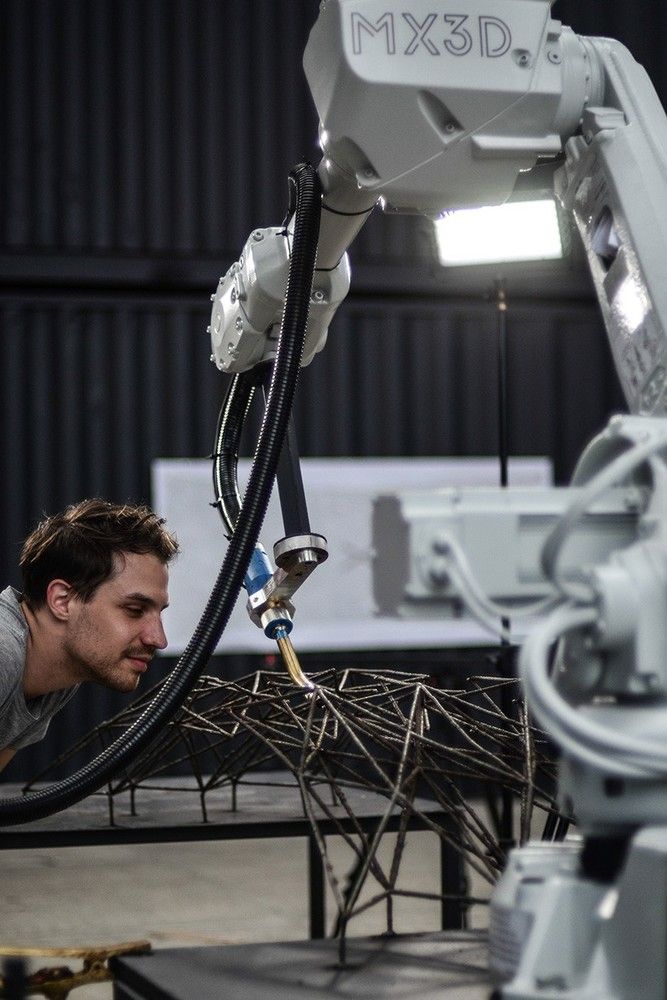
3. Gesture-Controlled (Gesture-Controlled Robotic Arm)
"One step closer to becoming Iron Man" is the motto of this unique device.
Hand gesture controlled robotic arm designed by Eben Couao. The structural elements of the movement are 3D printed. The author provides the complete code and detailed open source instructions, as well as a list of parts needed to reproduce the paddle.
The model consists of two systems: a robotic arm and a 3D printed glove that is used to control the movements of the hand. Movements, such as finger movements, can open and close the hand clamp, and wrist movements can move the entire arm.
The developer encourages users to come up with their own features for the robotic arm and share them on the GitHub platform so that they can further improve the device.
4. LittleArm Big
The LittleArm Big project can be described as "several arms coming together".
This is another educational model originally designed to be used as a teaching tool for high school and college students in STEM classes.
LittleArm Big is a complex 3D printed servo-assisted robotic arm developed by Slant Robotics in 2017. The device can measure up to 11.5 inches (approx. 29cm) and carry objects weighing up to 0.25 pounds (approximately 113 grams). The hand is designed for programming and can be controlled via Bluetooth as well as via Windows apps. To control this robot from iOS devices, you will need to migrate from Python code.
From less than 50 components of the LittleArm Big arm, 12 parts are 3D printed. These parts are not servos or electronics and are controlled by the Arduino Nano. The developers claim that the model can be assembled in less than two hours, but the assembly and adjustment of a manipulator with six DOF (degrees of freedom) may require the appropriate experience.
5. Scara and Scara printers
Scara robotic arms are highly accurate and easy to copy.
The term Scara stands for "selective assembly robotic arm". This is a type of robotic arm that can be 3D printed and used for 3D printing.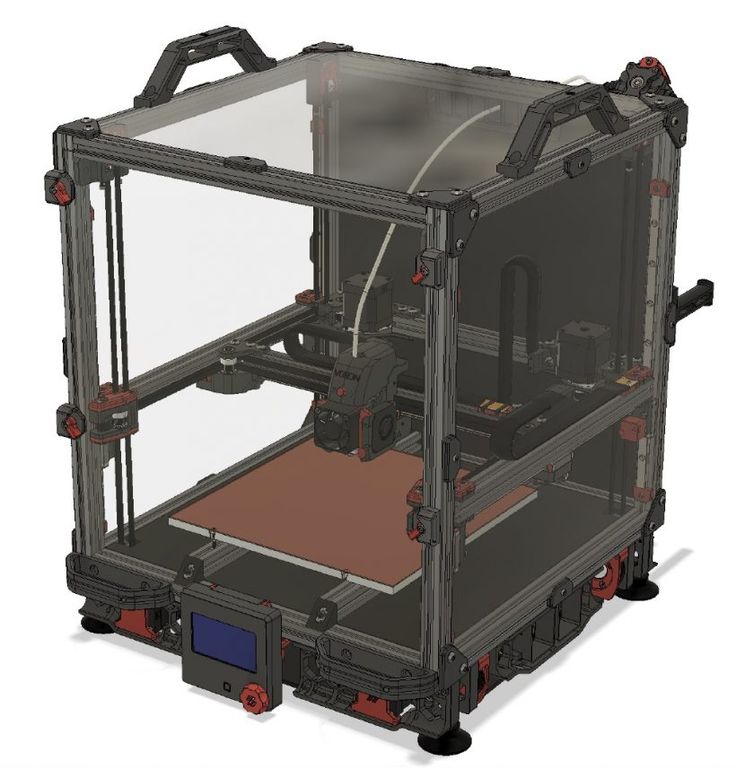
The type of movement of these manipulators allows for high accuracy, although they are more limited in degrees of freedom than other designs. Scara robots can be used to assemble more traditional robotic arms or specifically for 3D printing. Due to the simple geometry of the design, they are very easy to print on your own. With such a simple but smart system, you can print a new 3D printer or robotic arm.
Zoomorphic robots
Zoomorphic robots are robotic mechanisms that use the anatomical features and features of animals to work. Currently, one of the most popular are robots that move with movements that resemble crab. They are interesting in that they use a complex system of movements to move each of the "legs" in turn. Thanks to this, such mechanisms are able to move on different surfaces without any problems, unlike robots that use wheels to move. Wheeled robots are limited in movement, as they cannot move on some types of soil.
Consider the most modern models of zoomorphic robots with four or more legs.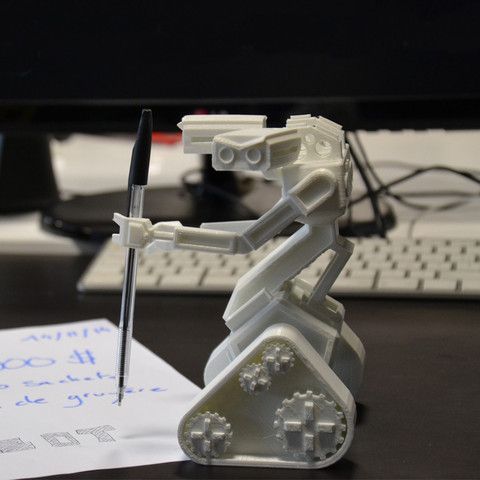
1. Strandbeest
This original robot walks in style like no other. The creation of this model was inspired by a mechanical design made by the Dutch artist Toe Janses, a developer of the Thingiverse service under the nickname nraynaud. Strandbeest is equipped with a walking mechanism consisting of a crankshaft that is connected to all legs. Each leg has several connecting rods, the dimensions of which were determined empirically. The whole structure moves with the help of motors, is controlled remotely and has a gait resembling that of a four-legged animal.
Driven by the force of the wind, Strandbeest can move forward or backward without turning as it has no forward direction. It needs at least four legs to move, but the number of limbs can be increased to any even number.
Like its prototype, the Strandbeest robot can rotate. Watching the robot gait is truly impressive, as the complex articular mechanism underlying the design allows for truly fluid movement.
The robot has simple electronics and is easy to program, so it is considered small. But where the device really stands out is that it has a complex system of joints.
The 3D printing files for this robot can be found on the Thingiverse website.
2. Flexoskeleton
Flexoskeleton walks like a beetle and moves like an obedient machine.
What happens when you combine flexible mechanisms and beetles? Flexoskeleton! This zoomorphic robot was designed by James Jiang, a graduate student at the University of California, San Diego. The mechanism of the device uses the flexibility of the material to mimic the flexibility of muscles. The body of the robot is completely 3D printed.
Instead of using screws and rods, the flexoskeleton uses the principle of a flexible mechanism to move the legs and return them to their natural position. This eliminates the need for joints, springs and pistons. The flexibility of the material acts as the robot's own spring. As a result, not only is less material wasted, but a more natural gait, reminiscent of that of a living being, is created. In addition, this design simplifies programming, since it is not necessary to take into account the movements of independent joints.
As a result, not only is less material wasted, but a more natural gait, reminiscent of that of a living being, is created. In addition, this design simplifies programming, since it is not necessary to take into account the movements of independent joints.
The flexoskeleton vividly demonstrates the principle that sometimes a solution doesn't have to be complex, just think about it differently.
3. OpenCat
OpenCat is Dr. Li's robotic cat model.
Rongzhong Li is an assistant professor at Wake Forest University in North Carolina and the creator of an open source 3D printed robotic cat. After OpenCat got into the weekly selection of videos about robots on the IEEE Spectrum website, a flurry of proposals fell upon the developer to further develop his personal project.
On his Hackster page, Dr. Lee explains that he started working on the project in the summer of 2016. Since then, his robotic cat has gone through seven iterations, each more difficult than the last.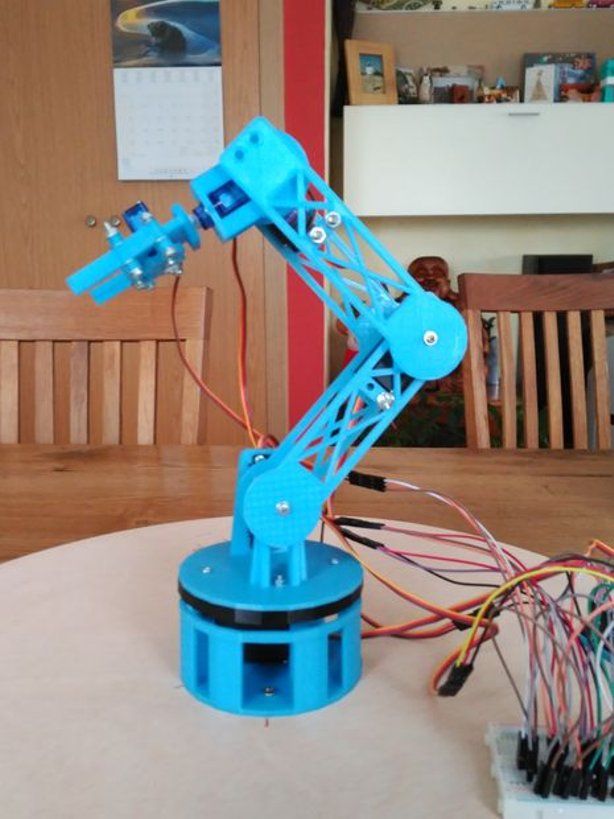
On the GitHub platform you can find a complete list of materials and files needed to create this cat. Dr. Lee recommends using ABS filament, rubber (TPU), conductive and nylon filaments.
The Doctor currently has two working models: a smaller one powered by an Arduino module for the STEM education and developer community, and a larger model with a built-in Raspberry Pi module for AI-enhanced perception.
Dr. Li is currently seeking funding to develop OpenCat from private to collaborative and eventually to a mainstream product.
4. Kame
The Kame robot is the very embodiment of movement. It's a 3D printed robot based on FreeCAD and shaped like a small quadruped. The mechanism was created in order to study the features of various gaits and the corresponding algorithms.
Built around the Esp8266 Wi-Fi module, Kame has eight servos (two for each leg), a small LiPo battery, and can be programmed with an Arduino. Watching him walk forward with unwavering confidence is both impressive and intimidating.
More information, including full FreeCAD sources and source code, can be found in the GitHub service repository. Detailed building instructions for this robot are also available on the Hackaday page.
5. Vorpal
The Vorpal hexapod robot is another great educational tool.
Vorpal is a design by Steve Pendergast. Since a successful crowdfunding campaign in 2018, this robot has continued to be a unique artisan project in classroom 3D printing.
The Vorpal robot is completely open source, can be programmed from scratch and controlled via Bluetooth. This is a great project for kids and adults to get familiar with robotics and coding. You can get more information about the project on the Vorpal Robotics website.
The Vorpal robot can be assembled by yourself (approximately $60), or purchased fully assembled or in kits for various levels of assembly.
6. Xpider
If you're afraid of insects and arachnids, you might not like the Xpider 3D printed robot that looks like a spider. But, fortunately, he does not look very scary and even quite harmless.
But, fortunately, he does not look very scary and even quite harmless.
Xpider was designed by the Chinese design team Roboeve in 2017. This tiny movement is 3.4 inches (8.6 cm) in diameter and weighs only 5.3 ounces (about 200 grams).
Xpider's key feature is the miniature camera mounted on its head. The robot makes its way and crawls through difficult obstacles to reach a given goal, and then transmits the footage to its operator. The shell of the device is printed on a 3D printer. Before reaching the final design, it was developed over several iterations.
On the Hackaday website you can find files for self-printing of the Xpider robot skin.
Small robots
Not all robots have to be complex or large to be considered cutting edge. Sometimes advanced features can be programmed or used for educational purposes, or as part of the study of one particular movement method.
Robotics has many interesting challenges and many aspects to experiment with. Reducing the size of mechanisms is one such challenge.
Reducing the size of mechanisms is one such challenge.
1. SMARS
The SMARS robot has a modular design, so the possibilities of its customization are truly endless.
SMARS is an acronym for Screwless/Screw Modular Robotic System. This simple and inexpensive 3D printed modular robot was created for use in education. It has a minimal number of components and can be assembled without screws, soldering or glue.
Thanks to the modular design of the robot, designers can easily install various sensors and tools into the mechanism, and even create their own parts. Inventor Kevin Thomas set the example by releasing a huge number of working mods. If you look for DLCs (additional modules) for SMARS, you can find ways to turn the robot into a quadruped or add a shovel to it, etc.
2. LittleBot
This manipulator arm can be modified to add new features.
LittleBot was created by Slant Concepts, formerly known as Slant Robotics, in 2017. The mechanism has a very simple chassis and operates on the basis of ultrasonic sensors that prevent the robot from colliding with objects. However, the beauty of this robot is that it can be programmed to perform many different functions, including line following, object detection, and noise recognition. LittleBot can even be used as a small accessory basket to connect additional Arduino components to enhance the robot's decision-making capabilities.
The mechanism has a very simple chassis and operates on the basis of ultrasonic sensors that prevent the robot from colliding with objects. However, the beauty of this robot is that it can be programmed to perform many different functions, including line following, object detection, and noise recognition. LittleBot can even be used as a small accessory basket to connect additional Arduino components to enhance the robot's decision-making capabilities.
LittleBot is a great starter robot for getting started with sounding and decision making. Originally developed as part of a Kickstarter campaign, it attracted 58 supporters, far exceeding the campaign's goal. Learn more about the project and its successors on YouTube, the Arduino Project Hub, and Hackster.io.
3. IMA Juno
The IMA Juno is a simple robot designed for beginning robotics.
In 2016, Canadian company Explore Making released the IMA Juno as an educational tool for learning the basics of robotics, Arduino coding, and 3D printing.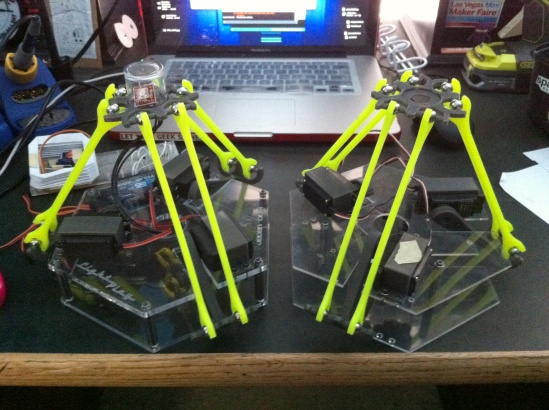 Based on SolidWorks, this educational robot can move forward, backward and turn sideways.
Based on SolidWorks, this educational robot can move forward, backward and turn sideways.
By following the step by step instructions, the user will learn about basic wiring, LED elements, servos and Arduino code. All Ima Juno 3D printed parts are optimized for printing on any desktop 3D printer (just keep in mind that you will have to use overhangs).
If you are looking for a deep 3D printing project, then the IMA Juno is the best choice for an initial application and an impressive little robot for its size.
4. Simple (robot without name)
This four-legged robot uses pencils as legs.
When it comes to making things, Randy Sarafan, a maker legend of sorts, comes into play. Randy founded the Instructables design studio, has written over 300 instructions, and has written several books on robotics and electronics. His unnamed 3D printed robot is fairly easy to print and build, and is easy to program and walk. All you need to make this mechanism is a 3D printer, servos, an Arduino module, 9-Volt battery, some nuts and bolts and four leg pencils. On his Instructables page, Randy gives detailed instructions for each step of the robot building process.
On his Instructables page, Randy gives detailed instructions for each step of the robot building process.
5. Buddy
Buddy is a cute, adorable “social” robot from LittleBots that is different from their robotic arms. The robot has a simple mechanism that is easy to do with your own hands. It is completely printed on a 3D printer, controlled using a programmable Arduino module and is designed to introduce social robotics. Buddy uses an ultrasonic sensor to "see" and interact with the world around him. Despite the fact that the robot has only three points of articulation, it is very expressive.
Check out the Instructables website for a tutorial and parts list for building Buddy.
6. Fighting
This fighting robot is capable of defeating other robots! He just can't hit.
The 3D printed combat robot, designed by Matt Cho, is a flexible robotic mech capable of performing combat moves such as an uppercut or a hook with both hands.
Currently, there are many modifications of combat robots, the main characteristics of which are high strength and resistance to falls.


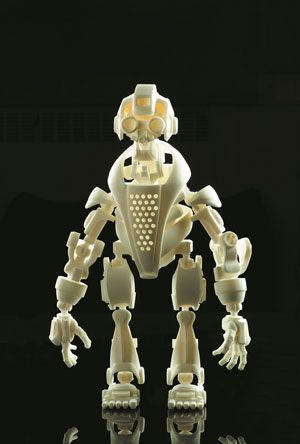 4 in
4 in

